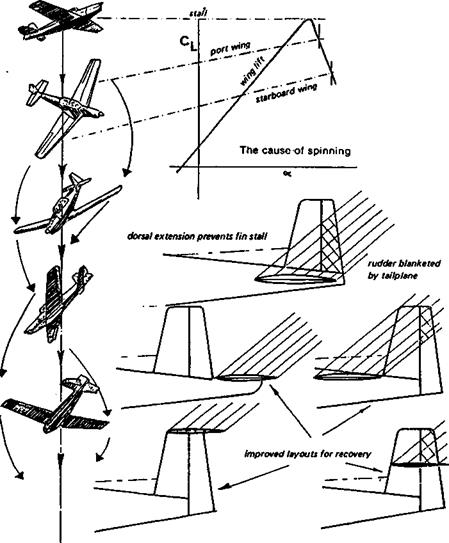POWER-ON BALANCE
So far both stability and balance have been discussed without reference to the effects of power. In longitudinal balance, the position of the thrust line relative to the model’s aerodynamic centre is of some importance. If the thrust line is relatively high or low a pitching moment arises which must, as a rule, be balanced by the tailplane. At the same time, the slipstream over the tail changes its lifting power for a given Cl, since the velocity of flow over it is greater. In a steep climb, the weight force still acts vertically down while the lift force of the wing is at right angles to the line of flight, which changes the balance to some extent if the c. g. is fairly low relative to the aerodynamic centre. The resulting, complex force system for a typical ‘pylon’ duration power model is sketched in Fig. 12.20. The trim of such a model is highly sensitive to small changes of power. A safer arrangement, if the model has variable camber and trim, and can be made to climb straight, is sketched in the lower part of Figure 12.20. Here it is supposed that the tail is symmetrical and at zero angle of attack relative to the downwash from the mainplane. The thrust line is directed through the model’s aerodynamic centre and the c. g. also is close to the thrust line, though still ahead of the neutral point The increased velocity of the slipstream over the tailplane, at zero angle of attack, creates no increase of pitching moment from that source. The tail becomes a stabiliser. The thrust line and drag create no pitching moment The wing pitching moment is small because the camber is reduced (flaps up) during the climbing phase of flight In practice no doubt this arrangement will not be attained exactly since some compromise with the requirements of glide trim and stability will still be needed, and the pitching moment coefficient will increase when the flaps go down at the end of the power run. In general, however, the climb of such a model should be less difficult to control, especially since no steep turning is required. Note that dihedral raises the centre of drag.
The speed of the slipstream over the tail of a radio controlled model changes the effectiveness of the controls so that rudder and elevator which are sensitive when power is lull may become insufficient for control on the glide. There is little hope of real escape
|
|
|
|
|
|
|

from this difficulty, but a satisfactory compromise is usually attainable.
The fact that the slipstream rotates may cause a model to swing on take off, since the flow over the fin and rudder is at an angle. This effect is more important than the torque of the propeller, which is a force tending, in the first instance to rotate the model in roll about the propeller shaft axis, rather than to turn or yaw it A bank induced by torque, of course, will lead to a turn if uncorrected, in the air. Such a rolling tendency can, on the ground, cause a swing because unequal load is thrown onto the undercarriage, but in flight the
natural way to control torque is by a counter rolling force from the wing, either a slight twist in the appropriate direction, or by means of a trim tab of aileron. In a power model climbing straight, this will probably be essential. The slipstream effect on the rudder may be controlled by ‘side thrust’ i. e. inclining the propeller shaft slightly to the fuselage datum line. This has die advantage that the correction operates only while the power is on, and does not affect the glide trim. In full-sized practice, the rudder is trimmed at various angles to give the same effect, or the whole fin is cambered slightly to give a constant anti-yaw effect Downthrust, as already mentioned, is often valuable to adjust the thrust line for longitudinal balance, and as before, the effect disappears when the motor cuts, so the glide trim is unaffected. Radio controlled models may imitate full-sized methods by trimming the controls appropriately for various flight conditions.











